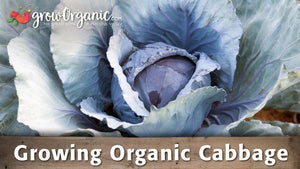Item Number: SNV1012
Organic All Season Cabbage Seeds
Versatile Garden Staple
Understanding All-Season Cabbage:
Varietal Diversity: All-season cabbage varieties, known for their adaptability, include green, red, and savoy types, each offering distinct flavors and textures. They form tight, round heads or crinkled leaves, depending on the variety.
Climate Adaptability: Specifically bred for adaptability, all-season cabbage thrives in various climates, making it suitable for a wide range of growing zones, including USDA zones 3-9.
Nutritional Value: Rich in vitamins K, C, and B6, as well as fiber and antioxidants, all-season cabbage provides a nutritional boost for a balanced diet.
Planting All-Season Cabbage:
Seed Selection: Choose all-season cabbage seeds from reliable suppliers, ensuring freshness and adaptability to diverse conditions.
Timing: Start seeds indoors 6-8 weeks before the last frost date or directly sow in early spring for a fall harvest, ensuring a continuous supply.
Soil Preparation: Create well-draining, fertile soil with a pH level between 6.0 to 6.8, amending with compost for enriched soil.
Spacing: Plant all-season cabbage seedlings 12-24 inches apart to allow ample space for growth and head development.
Ideal Growing Conditions:
Visual Description: All-season cabbage plants exhibit large, broad leaves forming tight, compact heads, displaying vibrant green, deep red, or purple hues, showcasing their adaptability and aesthetic appeal.
Sunlight: Thriving in full sun, all-season cabbage can tolerate partial shade, making it versatile for various garden settings.
Watering: Maintain consistent moisture levels, ensuring approximately 1-1.5 inches of water per week to support continuous growth.
Fertilization: Apply balanced fertilizer or compost during planting and use nitrogen-rich fertilizer during growth to sustain the plant's vigor.
Care and Maintenance:
Weed Control: Regularly weed to reduce competition for nutrients and water, ensuring optimal conditions for all-season cabbage.
Pest Management: Monitor and manage common pests like cabbage worms or aphids using organic methods, ensuring the plant's health.
Disease Prevention: Practice crop rotation and avoid overhead watering to prevent diseases like clubroot or black rot.
Harvesting All-Season Cabbage:
Timing: All-season cabbage matures in approximately 70-120 days after planting, allowing for continuous harvests throughout the growing season.
Visual Cues: Look for firm, solid heads when gently pressed, indicating readiness for harvest.
Harvest Technique: Use a sharp knife to cut the cabbage at the base, leaving a few outer leaves for protection during storage.
Storing and Usage:
Storage: Preserve harvested all-season cabbage in a cool, humid environment to extend its shelf life for use in diverse culinary applications.
Usage: Utilize all-season cabbage in an array of dishes, from salads and coleslaw to stir-fries, soups, and fermented delights like sauerkraut. All-season cabbage, bred for adaptability across USDA zones 3-9, offers gardeners the versatility to enjoy a continuous harvest of vibrant and nutritious cabbage throughout the year. Following these steps ensures a successful and rewarding experience in cultivating all-season cabbage in your garden.




Check Your Zone Compatibility:
Compatible with your zone.
Growing Zone for

Our Guarantee To You
Since 1976, we've served our customers at every stage of growing. Please contact us at any time. We are happy to support and assist you.
Shipping Information
Shipping Information
Shipping Weight: 0.02 lb
Dimensions: 4.5"L x 3.25"W x 0.1"H
Features
Features
- Open-Pollinated
Characteristics
Characteristics
Planting & Care
Planting & Care
Soil & Water: Cabbage prefers rich, fertile soil with a pH of 6.0-7.5. Water heavily from planting to head formation, then water moderately to prevent splitting. Cabbage is a hardy crop, grown best in cool spring and fall temperatures.
Planting & Growing: Start indoors 8 weeks before last frost, or outdoors March through June. Fast growing or stressed cabbages tend to split and bolt; cutting into the root system will slow growth and prevent splitting. Provide transplants with cutworm shield collars.
Harvesting & Storage: Early types of cabbage grow and mature quickly and must be harvested promptly to avoid splitting. Heads store well in cool (32°F-40°F), moist locations for 5-6 months.
Useful Information
Useful Information
Guarantee
Guarantee
Share







